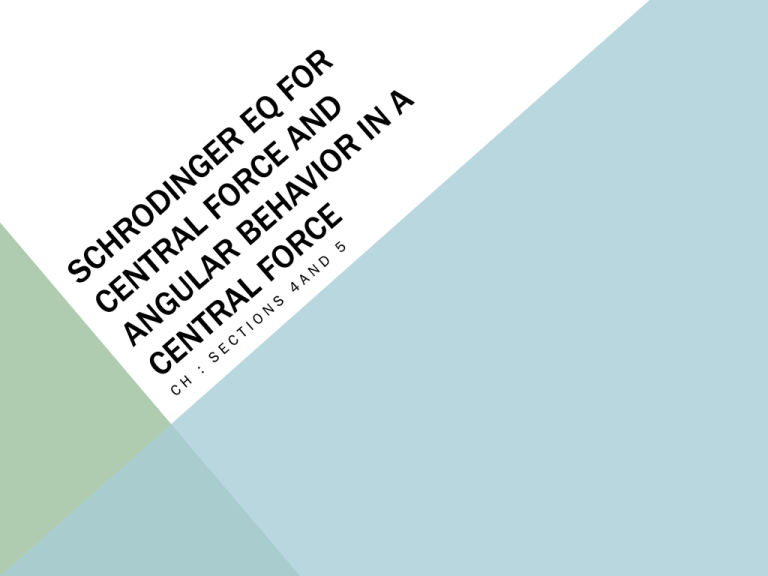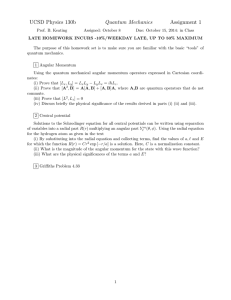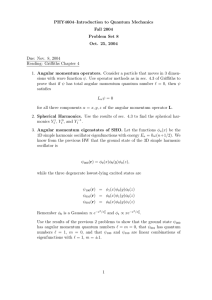Document 11081876
advertisement

SPHERICAL POLAR COORDINATES • The position is indicated by the vector r. • It has a length (magnitude) r. • The polar angle θ is measured from the z axis. • The azimuthal angle φ is measured from the x axis. • Trigonometry is used to convert between polar and Cartesian coordinates (see fig.) • The volume element is 𝑑𝑑𝑑𝑑 = 𝑟𝑟2 sin 𝜃𝜃 𝑑𝑑𝑑𝑑𝑑𝑑𝜃𝜃𝑑𝑑𝜙𝜙 CENTRAL FORCE • If the potential energy does not depend on the polar or azimuthal angle, U (r) = U(r), then force is radial and known as a central force. The coulomb force in the hydrogen atom is a central force. So our goal is to solve Schrodinger’s equation in the case of a central force. • In 3-D, we have − • • • • ℏ2 2 ∇ 𝜓𝜓(𝒓𝒓) 2𝑚𝑚 + 𝑈𝑈(𝒓𝒓)𝜓𝜓(𝒓𝒓) = 𝐸𝐸𝜓𝜓(𝒓𝒓) Where in spherical coordinates, we have 1 𝜕𝜕 2 𝜕𝜕 𝜕𝜕 𝜕𝜕 𝜕𝜕2 2 2 𝛻𝛻 = 2 𝑟𝑟 + csc 𝜃𝜃 sin 𝜃𝜃 + csc 𝜃𝜃 2 𝑟𝑟 𝜕𝜕𝜕𝜕 𝜕𝜕𝜃𝜃 𝜕𝜕𝜕𝜕 𝜕𝜕𝜙𝜙 𝜕𝜕𝜕𝜕 As in the case of the 3-D infinite well, we assume we can separate variables: 𝜓𝜓 𝒓𝒓 = 𝑅𝑅 𝑟𝑟 Θ 𝜃𝜃 Φ 𝜙𝜙 As in the case of the 3-D infinite well, we assume we can separate variables, we sub into Schrodinger's equation and find 3 separate DiffEqs: azimuthal, polar and radial. (We’ll do the angular ones today and the radial one next time. ) Everything we do today can be applied to any central force problem. AZIMUTHAL 𝜕𝜕2Φ 𝜕𝜕𝜕𝜕2 • The azimuthal DiffEq is the simplest: • We’ve solved this many times, here the best solution is Φ 𝜙𝜙 = 𝑒𝑒𝑒𝑒 𝐷𝐷 𝜙𝜙 • = −𝐷𝐷Φ Of course, Φ 0 = Φ 2𝜋𝜋 = Φ 4𝜋𝜋 … • This condition can only be met if 𝐷𝐷 = 𝑚𝑚ℓ where 𝑚𝑚ℓ is a positive or negative integer including zero. (We’ll give a more exact range of values after we consider the polar solution.) • So we’ve found our first quantum number 𝑚𝑚ℓ. It is called the magnetic quantum number. In this case it does NOT indicate that energy is quantized. Instead it tells us that the z component of the angular momentum is quantized. QUANTIZED LZ • Similar to what we saw in the Bohr atom, there are circular standing waves. • The wavelengths are given by 2π𝑟𝑟 = 𝑚𝑚ℓ𝜆𝜆 . • The momentum is ℎ 𝑝𝑝 = = 𝑚𝑚𝑚𝑚𝑚𝑚 𝜆𝜆 ℎ𝑚𝑚ℓ ℏ𝑚𝑚ℓ = = 𝑚𝑚𝑚𝑚𝑇𝑇 2π𝑟𝑟 𝑟𝑟 𝑚𝑚𝑚𝑚𝑇𝑇𝑟𝑟 = 𝑚𝑚ℓ ℏ 𝐿𝐿𝑧𝑧 = 𝑚𝑚ℓ ℏ POLAR • • • • • The polar DiffEq depends on 𝑚𝑚ℓ sin 𝜃𝜃 𝜕𝜕 𝜕𝜕𝜕𝜕 sin 𝜃𝜃 𝜕𝜕Θ 𝜕𝜕𝜕𝜕 − (𝐶𝐶 sin 2𝜃𝜃)Θ = 𝑚𝑚ℓ2 Θ The solution involves Legendre functions. (We usually need ΘΦ—called spherical harmonics see Table 7.3.) Physical solutions require certain values for C and 𝑚𝑚ℓ. The allowed values are: 𝐶𝐶 = −ℓ ℓ + 1 where ℓ = 0, 1, 2, … and 𝑚𝑚ℓ = 0, ±1, ±2 … ± ℓ So the z-component of the angular momentum is 𝐿𝐿𝑧𝑧 = 𝑚𝑚ℓ ℏ where 𝑚𝑚ℓ = 0, ±1, ±2 … ± ℓ We’ve found another quantum number ℓ. It is called the orbital quantum number, but what physical property is quantized? TO ANSWER THIS QUESTION… In class problem 7.42. Please write on the board. ANGULAR MOMENTUM IS QUANTIZED • • • So the magnitude of the angular momentum 𝐿𝐿 = ℓ(ℓ + 1)ℏ is quantized. And so is one component 𝐿𝐿𝑧𝑧 = 𝑚𝑚ℓ ℏ This is required by the uncertainty principle. ANGULAR PROBABILITY DENSITY HOMEWORK Ch 7: 37 (Due 10DEC, Thursday—same day as Test 4)




